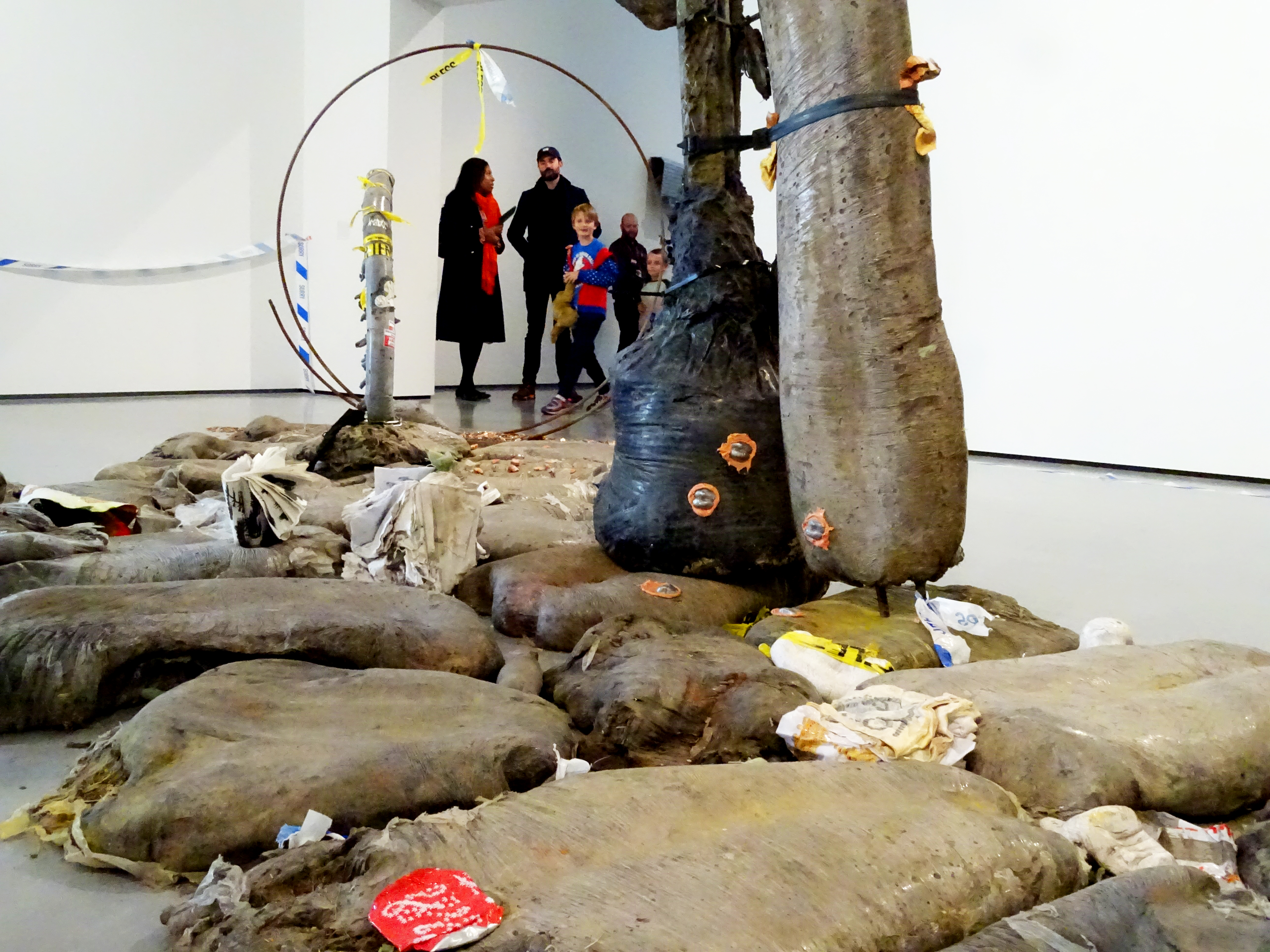There is a distant droning of a mechanical organ drifts throughout the galleries at the Hepworth Wakefield as the thirty-seven crystal glass flutes of Cerith Wyn Evans’ work recycles the breath of the viewer into deep sounds. But like the air that flows through the two-part sculpture, the work feels a bit empty and detached, the flutes seem to murmur “money,” as this clinical sci-fi sculpture looks like an expensive bit of kit rather than an engaging sculptural object as the artist intended. Wyn Evans is known (amongst other things) for his white neon light ‘scribble’ sculptures and I found myself disappointed that this piece did not light up as expected. The sculpture could be difficult for members of the public to embrace, but it is not as challenging as the work of Phillip Lai.
Lai’s work comprises of several high shelves with piles of foam mats and hand-casted plastic ‘basins’ with smears of cement, that give the impression of a strangely ordered construction site. There is an installation featuring a pile of colourful clothes and, like Wyn Evans, another ‘clinical’ sculpture in the form of a large aluminium countertop with two oversized objects that resemble a futuristic cross between a watering can and a teapot. The gallery is sparse, and whilst Lai says that he tries to make nearly all the elements of his work himself, they come across as fabricated and lifeless.
In a similar vein, the sculptures of Magali Reus evoke a sense of manufacture, but whilst her two series of sculptures are actually fabricated according to her designs, compared to the work of Lai, they better express personality and don’t take themselves too seriously. The sculptures resemble domestic objects in sickly colours, such as a ladder or hat stand, featuring items that look like wine bottles or a traditional fire hose found outside a hotel room. Reus’ sculptures are similar to these objects that we are familiar with, yet are uncanny; the forms are not explicit, but more ‘suggestions of objects’, evoking associations with ‘people, places, smells and sounds’.
Mona Hatoum’s sculptures concern politics on an international level, referential of conflicts in the Middle East and around the world. Hot Spot, a mesh globe with continent outlines in red neon, and Orbital, a steel rod sphere joined together by balls of concrete from demolished buildings, both explore a sense of growing violence in the world. Hatoum’s interests seem exaggeratedly serious and ‘mature’ in comparison to the lighter works of the above artists.
Michael Dean’s Of Or for LOL, is a seemingly cluttered installation which on closer inspection is littered with clues and complex details. The sculptural works resemble a pavement with concrete slabs winding across the gallery, objects poke out such as crushed coke cans, casted fists, crossed fingers and puckered lips, decaying books with laughing-crying emojis and weed symbols, wire love hearts covered in padlocks, and a pile of pennies that add up to a day’s pay on National Minimum Wage. The larger sculptures in the installation come together to form the word ‘LOL’, known to mean ‘laugh out loud’, but Dean also plays on the fact that David Cameron used this phrase to signify ‘lots of love’. It is interesting that the work encourages the audience to step onto it and explore the scene up close. The installation feels like a post-apocalyptic vision of deprived areas in Britain and like Hatoum’s work, speaks strongly about issues of politics and class, but on a more national level, whilst retaining an element of comicality. In my opinion, Dean is a clear winner for the prize as his scruffy installation stands out against the pristine works of the other artists.
The £30,000 Hepworth Prize for Sculpture recognises a ‘British or UK-based artist of any age, at any stage of their career, who has made a significant contribution to the development of contemporary sculpture’. It is named after the prominent sculptor Barbara Hepworth. The winner of the Hepworth Prize for Sculpture 2018 will be announced on the 15th of November. There is also a People’s Choice award that you can vote for and the winner will be announced in January 2019. The exhibition is on at the Hepworth Wakefield until 20th January 2019.
D’arcy Darilmaz
Image Courtesy of D’arcy Darilmaz

